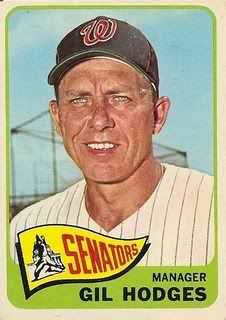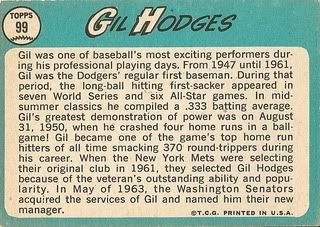
I'm reasonably sure that this is my first Gil Hodges card; it's certainly my first vintage card of the slugger. He just seems like one of the cooler players of his era, though I tend to be a sucker for hulking slugging first basemen: Jimmie Foxx, Frank Howard, Boog Powell, Ted Kluszewski, you name it.
Fun facts about Gil Hodges:
-Gil was born in Princeton, IN, and starred in track, baseball, football, and basketball at Petersburg High School. He attended St. Joseph's College in Indiana before signing with the Dodgers in 1943.
-He played a single game with Brooklyn in 1943, but missed the next few seasons to serve as an anti-aircraft gunner with the Marines in World War II. He participated in battles at Okinawa and Tinian and received a Bronze Star for his efforts.
-After struggling in 1947 and putting things together in 1948, he truly flourished in 1949. Manager Leo Durocher switched him from catcher to first base, and Gil responded with a .285 average, 23 home runs, 115 RBI, and 94 runs scored in the first of his 8 All-Star seasons. He tied with Duke Snider for the team lead in homers, and trailed only Jackie Robinson's 124 runs batted in. He would top 20 home runs in 11 straight seasons.
-On August 31, 1950, he keyed a 19-3 Dodgers romp over the Braves with 4 home runs and 9 RBI. Each of his longballs came with men on base, and he finished the day 5-for-6 with 5 runs scored.
-In 1954, he set career highs in several categories, batting .304, slugging .579, and belting 42 homers with 130 RBI.
-Hodges was no lumbering giant: he won three straight Gold Gloves at first base, 1957-1959.
-Playing most of his career with the Dodgers afforded Gil the opportunity to play in seven World Series, of which the team won two. In 39 Fall Classic games, he hit .267 (35-for-131) with 5 home runs and 21 RBI. In Game 4 of the 1955 Series, he went 3-for-4 with 3 RBI, and his 2-run homer off of Don Larsen gave Brooklyn a lead it would not relinquish. He drove in the only pair of runs in that year's Game 7 clincher, completing a comeback from a 2-0 Series deficit against the Yankees.
-He spent parts of 16 seasons in Dodger Blue before ending his career with 65 games for the Mets in the 1962 and 1963 seasons. He retired as a player after the Senators traded Jimmy Piersall to acquire him as their manager in May 1963. For his career, he batted .273 with a .359 on-base percentage, 370 home runs, and 1,274 RBI. His 361 homers and 1,254 RBI as a Dodger are second in franchise history to Duke Snider (389 HR and 1,271 RBI).
-In four-plus seasons at the helm in Washington, his clubs never posted a winning record, but did improve by a few games per year. They went from 56-106 in 1963 to 76-85 in 1967. The following year, he returned to the Mets, replacing interim skipper Salty Parker. After guiding the club to a new franchise-best of 73 wins in 1968, he oversaw their transformation into the Amazin' Mets of 1969. They came out of nowhere to win 100 games, roaring from behind to beat out the Cubs for the National League pennant. New York then stunned the heavily-favored Orioles in a five-game World Series with timely hitting, spectacular defensive plays, and superlative pitching from the likes of Jerry Koosman, Gary Gentry, and Tom Seaver. Hodges was named Manager of the Year. His Mets slipped back to third place in both the 1970 and 1971 seasons.
-He had suffered a heart attack during the 1968 season, and another cardiac episode during spring training in 1972 caused his untimely death at age 47. The Mets retired his number 14 the following year, and inducted him into their Hall of Fame in 1982. He was also inducted into the Marine Corps Sports Hall of Fame in 2007, and several locations and facilities both in Brooklyn and in his hometown in Indiana bear his name today.



No comments:
Post a Comment